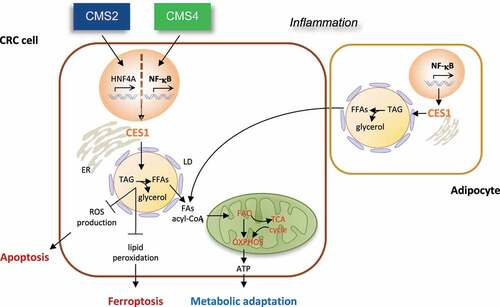Figures & data
Figure 1. Carboxylesterase (CES)1-dependent metabolic rewiring in colorectal carcinoma (CRC) etiopathogenesis. CES1 is upregulated by HNF4A and NF-κB in the Consensus Molecular Subtype (CMS)2 and CMS4 CRC subtypes and promotes tumor cell survival by increasing triacylglycerol (TAG) breakdown to fuel fatty acid oxidation (FAO) and oxidative phosphorylation (OXPHOS) during starvation and preventing toxic lipid accumulation, which triggers apoptosis and ferroptosis. as CES1 is also expressed in adipocytes, we speculate it may also play a role in the symbiosis of CRC cells with adipocytes.

